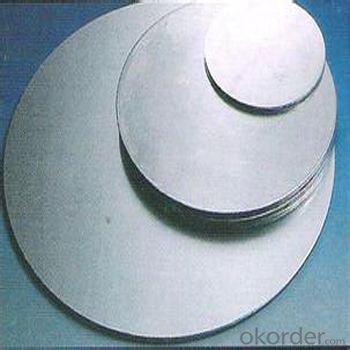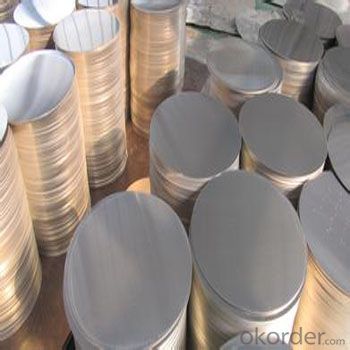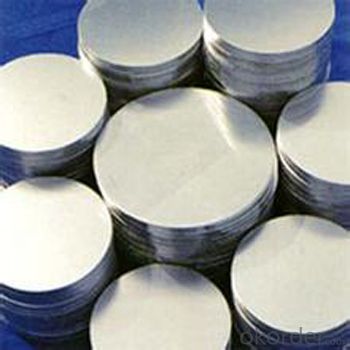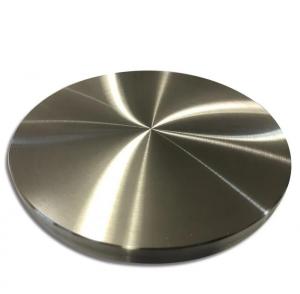Aluminum Circle Aluminium Round Plate DC&CC
- Loading Port:
- Shanghai
- Payment Terms:
- TT or LC
- Min Order Qty:
- 5 m.t.
- Supply Capability:
- 100 m.t./month
OKorder Service Pledge
OKorder Financial Service
You Might Also Like
1.Specification
ALUMINIUM CIRCLE
2.Description
Aluminium foil has a shiny side and a matte side. The shiny side is produced when the aluminium is rolled during the final pass. It is difficult to produce rollers with a gap fine enough to cope with the foil gauge, therefore, for the final pass, two sheets are rolled at the same time, doubling the thickness of the gauge at entry to the rollers. When the sheets are later separated, the inside surface is dull, and the outside surface is shiny. This difference in the finish has led to the perception that favouring a side has an effect when cooking. While many believe that the different properties keep heat out when wrapped with the shiny finish facing out, and keep heat in with the shiny finish facing inwards, the actual difference is imperceptible without instrumentation.
Thin sheets of aluminium are not very effective at attenuating low-frequency magnetic fields. The shielding effectiveness is dependent upon the skin depth. A field traveling through one skin depth will lose about 63 percent of its energy (it is attenuated to 1/e = 1/2.718... of its original energy). Thin shields also have internal reflections that reduce the shielding effectiveness. For effective shielding from a magnetic field, the shield should be several skin depths thick. Aluminium foil is about 1 mil (25 µm); a thickness of 10 mils (250 µm) (ten times thicker) offers less than 1 dB of shielding at 1 kHz, about 8 dB at 10 kHz, and about 25 dB at 100 kHz.
3.Why you want to choose us?
We can supply the best quality and best service!
4.Pictures



5.FAQ
1)Can we supply samples?
Yes, we can!
2)What can you do if you have other quastions?
You can contact us freely at any time!
3)How about our payment term?
LC and TT and other.
- Q:I want to make a part using molten aluminum with a hole through the middle and would like to use a steel rod to do this. Would the bar stick to the aluminum when it cools and not be able to be removed? If so is there so type of coating I can use so it can be removed?
- Aluminium and iron are pretty incompatible materials, they don't form an alloy I don't think, so it is unlikely they would stick. Also, both metals will get an oxide layer on the surface which should keep them separate. Try it! If the finished part does stick, try heating the aluminium then dip the steel rod in some ice water.
- Q:Are there any health risks associated with using aluminum sheets?
- The use of aluminum sheets has sparked ongoing debate and research due to potential health risks. Although aluminum is widely utilized in various industries and products, it is crucial to consider certain factors. Health issues have been linked to exposure to high levels of aluminum through inhalation or ingestion. Studies suggest that aluminum exposure may be connected to neurological disorders like Alzheimer's disease or Parkinson's disease, as well as respiratory problems and bone disorders. Nevertheless, it is important to note that these studies have not definitively established a causal relationship between aluminum and these health conditions. The primary concern with aluminum lies in its ability to leach into food or beverages when it comes into contact with acidic or salty substances. This leaching can happen during food preparation or storage, especially when using aluminum cookware or foil. Consuming excessive amounts of aluminum through food or drink may pose health risks, especially for individuals with kidney disease or those who are more susceptible to aluminum toxicity. To minimize potential health risks, it is recommended to avoid using aluminum cookware or foil when cooking or storing acidic or salty foods. Instead, consider utilizing alternatives such as stainless steel, glass, or silicone. In conclusion, while there are worries about the potential health risks associated with using aluminum sheets, further research is necessary to establish a clear cause-and-effect relationship. It is wise to reduce exposure to aluminum, particularly through food and beverages, by taking preventive measures and employing alternative materials when suitable. Seeking guidance from healthcare professionals and staying informed about the latest research can assist individuals in making informed decisions regarding the use of aluminum sheets and other aluminum products.
- Q:my grandpa gave me a family harloom, a 1971 Honda Trail 90, after it sat in a shed for a good 30 years. i have got most everything in tip top shape except for the polished aluminum has become lightly tarnished. and because i am a perfectionist
- Buy LOW TEMP aluminum paint and make it look like new.I have restored 1 1985 and that is a lot of work and well worth the results.Nice Job on the 71.
- Q:What is the fatigue strength of aluminum sheets?
- The fatigue strength of aluminum sheets varies depending on several factors such as the alloy composition, thickness, surface condition, and the specific loading conditions. Aluminum alloys generally exhibit good fatigue strength, particularly when compared to other metals. The fatigue strength of aluminum sheets is typically determined through fatigue testing, where specimens are subjected to cyclic loading until failure. The S-N curve, which represents the relationship between the number of cycles to failure (N) and the applied stress amplitude (S), is used to characterize the fatigue behavior of aluminum sheets. Aluminum alloys, such as 2024-T3 and 6061-T6, commonly used in aerospace and automotive industries, have high fatigue strengths and can withstand millions of cycles at certain stress levels. For example, 2024-T3 aluminum alloy has a fatigue strength of approximately 105 MPa (15,000 psi) at 10^6 cycles, whereas 6061-T6 aluminum alloy has a fatigue strength of around 96 MPa (14,000 psi) at the same number of cycles. It is important to note that the fatigue strength of aluminum sheets can be influenced by various factors, such as the presence of surface defects, corrosion, temperature, and loading frequency. Proper surface preparation, including smoothing and removing sharp edges, can increase the fatigue strength of aluminum sheets. Additionally, the use of proper stress relief treatments and design considerations, such as avoiding stress concentrations and optimizing joint design, can also improve the fatigue performance of aluminum sheets. Overall, the fatigue strength of aluminum sheets is generally considered to be good, but it is important to consider the specific alloy, thickness, surface condition, and loading conditions to accurately determine and optimize the fatigue performance in practical applications.
- Q:Can 101 aluminum sheets be used in aerospace applications?
- Indeed, aerospace applications can make use of 101 aluminum sheets. This particular alloy, known as 101 aluminum, is widely employed in the aerospace sector because of its remarkable strength-to-weight ratio, superior resistance to corrosion, and impressive formability. It is frequently utilized in the creation of structural elements, including aircraft skins, wings, and fuselage panels. Furthermore, 101 aluminum sheets can be effortlessly machined and welded, rendering them exceptionally suitable for aerospace applications that demand precision and durability.
- Q:Can aluminum sheets be used for boat building?
- Yes, aluminum sheets can be used for boat building. Aluminum is a popular material choice for boat construction due to its lightweight nature, durability, and resistance to corrosion. Aluminum sheets are commonly used in the construction of small recreational boats, larger yachts, and even commercial vessels. They offer several advantages such as being easy to work with, providing excellent strength-to-weight ratio, and requiring minimal maintenance. Additionally, aluminum boats are known for their superior buoyancy, stability, and fuel efficiency. Overall, aluminum sheets are a suitable and reliable option for boat building.
- Q:Can aluminum sheets be anodized?
- Yes, aluminum sheets can be anodized. Anodizing is an electrochemical process that creates a protective oxide layer on the surface of the aluminum. This layer enhances the metal's corrosion resistance, durability, and appearance. Anodizing is commonly used in various industries such as automotive, aerospace, and construction to provide a protective coating and improve the aesthetics of aluminum sheets. The process involves immersing the aluminum sheet in an acid electrolyte solution and passing an electric current through it, causing oxygen ions to bond with the aluminum atoms and form the oxide layer. This layer can be further enhanced with the addition of dyes or pigments to create different colors and finishes. Overall, anodizing is a versatile and effective method for treating aluminum sheets.
- Q:what's the size of gap while pressing 6mm aluminum sheet?
- unilaterial gap is 0.1-0.15mm, and you can change the gap according to cutting effect.
- Q:How do aluminum sheets perform in terms of thermal insulation?
- Aluminum sheets are not effective in terms of thermal insulation. Due to their high thermal conductivity, aluminum sheets allow heat to easily transfer through them. This means that they are not able to effectively block or resist the transfer of heat, resulting in poor thermal insulation properties. If thermal insulation is the primary concern, other materials such as fiberglass, foam, or mineral wool would be more suitable choices.
- Q:Are aluminum sheets suitable for automotive applications?
- Yes, aluminum sheets are suitable for automotive applications. Aluminum is a lightweight material that offers several advantages for automotive use. Firstly, aluminum is highly corrosion resistant, making it ideal for exterior parts that are exposed to harsh environments. Additionally, aluminum offers great strength-to-weight ratio, meaning it provides high strength while keeping the overall weight of the vehicle low. This leads to improved fuel efficiency and better performance. Aluminum sheets are also easily formable, allowing manufacturers to create complex shapes and designs for various automotive components. Furthermore, aluminum is recyclable, making it an environmentally friendly choice. Overall, the use of aluminum sheets in automotive applications offers numerous benefits, including weight reduction, improved fuel efficiency, corrosion resistance, and design flexibility.
1. Manufacturer Overview |
|
|---|---|
| Location | |
| Year Established | |
| Annual Output Value | |
| Main Markets | |
| Company Certifications | |
2. Manufacturer Certificates |
|
|---|---|
| a) Certification Name | |
| Range | |
| Reference | |
| Validity Period | |
3. Manufacturer Capability |
|
|---|---|
| a)Trade Capacity | |
| Nearest Port | |
| Export Percentage | |
| No.of Employees in Trade Department | |
| Language Spoken: | |
| b)Factory Information | |
| Factory Size: | |
| No. of Production Lines | |
| Contract Manufacturing | |
| Product Price Range | |
Send your message to us
Aluminum Circle Aluminium Round Plate DC&CC
- Loading Port:
- Shanghai
- Payment Terms:
- TT or LC
- Min Order Qty:
- 5 m.t.
- Supply Capability:
- 100 m.t./month
OKorder Service Pledge
OKorder Financial Service
Similar products
New products
Hot products
Hot Searches
Related keywords





























